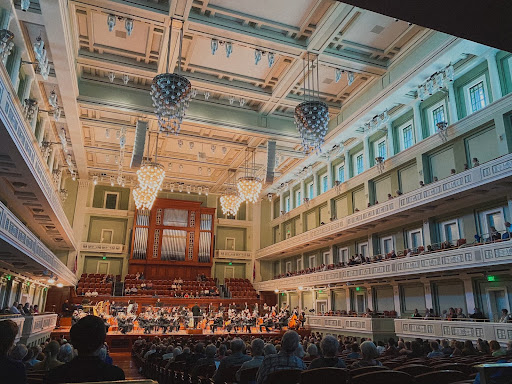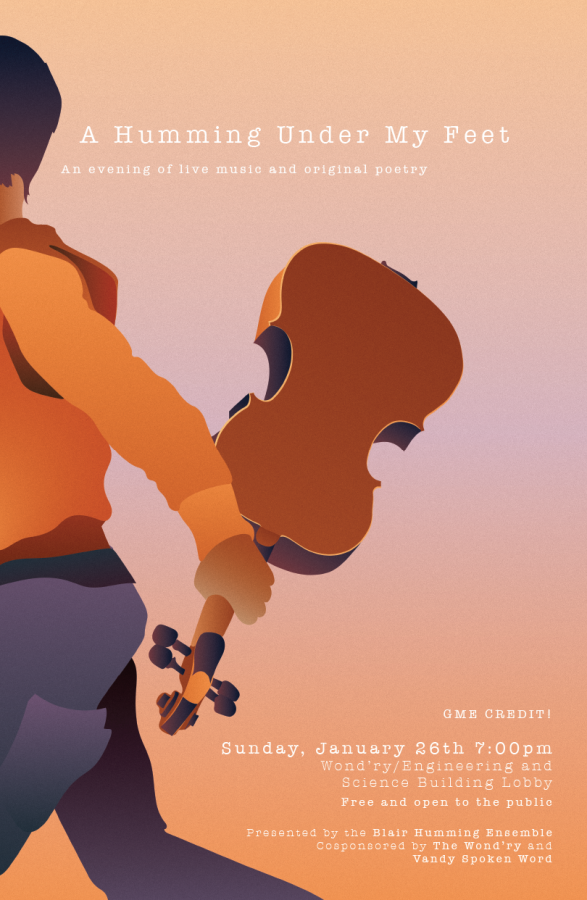When considering the countless opportunities there are in Nashville to listen to live music, one might not think of attending a Nashville Symphony Orchestra (NSO) concert at the Schermerhorn Symphony Center. However, for students like me (who grew up playing and listening to classical music) this type of concert images up the most enjoyable Sunday afternoon.
On April 10, the Symphony performed “Mendelssohn’s Violin Concerto & Debussy’s La Mer.” The concert, which ran from April 8-10, featured composers from the 19th and 20th centuries. Audience members filled the hall as beautiful, decadent chandeliers hung above them.
The performance began with “Hiawatha: Suite from the Ballet, Op. 82a” by Samuel Coleridge-Taylor. Coleridge-Taylor is new to composing, illustrated by this being NSO’s first-ever performance of “Hiawatha.” However, this newcomer status did not dampen the exciting and innovative aspects of the performance.
Coleridge-Taylor included six movements within the piece. When listening, it was clear that he composed each movement to aid in telling an overall story. The particular piece mentioned above was inspired by Henry Wadsworth Longfellow’s epic poem “Hiawatha.” From “The Wooing” and “The Marriage Feast” to “The Departure” and “Reunion,” Coleridge-Taylor was skillful in using different soloists and sections of the orchestra to make shifts in the atmosphere. Through his piece, NSO was able to bring the audience on a journey through love, joy and acceptance.
The second piece performed during the concert was Felix Mendelssohn’s “Violin Concerto.” The piece featured internationally acclaimed violinist Adele Anthony. As Mendelssohn composed this piece about 80 years before Coleridge-Taylor’s “Hiawatha,” it requires a smaller orchestra. However, the piece still touches on an incredible range of emotions.
For me, the first movement felt like a journey from desperation to happiness. Anthony’s spectacular technique was prominently featured, especially in the cadenza section when she was briefly an unaccompanied soloist. The orchestra seamlessly transitioned to the second movement. Mendelssohn’s incredible ability in lyricism shined with his heart-aching melodies played gorgeously by Anthony and NSO. The third movement returned to a fast tempo and gave the piece a grand ending. Overall, Anthony and NSO played together beautifully and was far deserving of the standing ovation they received.
After the brief intermission, NSO continued with another composition by Coleridge-Taylor, “Ballade in A minor, Op. 33.” He had the orchestra tell a lyrical narrative throughout the piece, similar to Hiawatha, even though ballades were more commonly associated with solo-piano compositions. Coleridge-Taylor used the contrasts of the brass section and strings to create a full sound that emphasizes the many colors within the orchestra.
The final piece, Debussy’s “La Mer,” was a piece described by his biographer (Louis Laloy) as “an impressionism of the emotions, translated into harmonies unique to the world.” With his other famous compositions such as “Claire de Lune,” which depicts moonlight, it is not surprising how well Debussy’s piece depicts the sea.
With the first movement, “From Dawn to Noon on the Sea,” Debussy depicts both the gentleness and intensity of the sea. It began with rumbling sounds from the strings and later reaches a strong climax, the image of a wave crashing, emphasized by the use of the gong. The second movement, “Play of the Waves,” showcased fun and mysterious sounds from the orchestra. Mutes were used in the trumpet section, and the harps were heard playing glissandos.
In the final movement, “Dialogue of Wind and Sea,” the orchestra had moments of both swelling in fury and playing eerie melodies in a quiet tone. An additional dramatic flair ended the concert, and NSO once again received a well-deserved standing ovation.
More concerts will be held at the Schermerhorn Symphony Center over the next few months, and the Symphony offers a discounted price of $10 for students.











